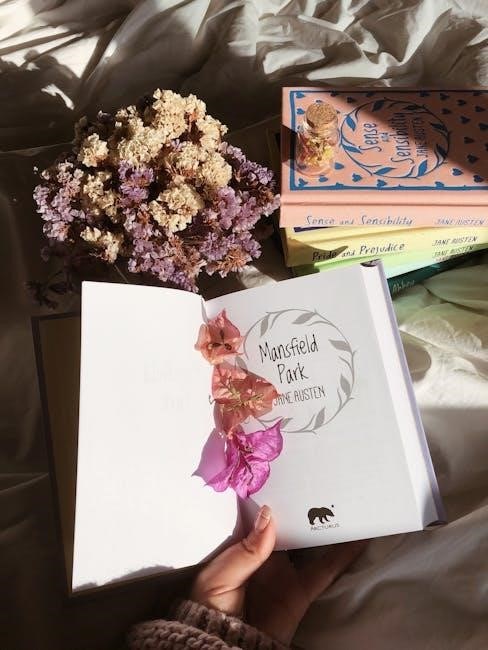Chimamanda Ngozi Adichie’s Purple Hibiscus is a poignant exploration of family, culture, and identity in post-colonial Nigeria, centered around Kambili’s journey from silence to self-discovery.
Overview of the Novel
Purple Hibiscus, Chimamanda Ngozi Adichie’s debut novel, is a compelling narrative set in post-colonial Nigeria. It follows Kambili Achike, a teenage girl, as she navigates her oppressive home life, religious conflicts, and cultural expectations. The story explores themes of freedom, identity, and the struggles of a family under the tyrannical rule of Papa Eugene, a devout Catholic and controlling patriarch. The novel weaves together personal and political tensions, offering a vivid portrayal of societal norms and individual rebellion. Through Kambili’s journey, Adichie examines the clash between tradition and modernity, creating a powerful tale of self-discovery and transformation.
Author Background: Chimamanda Ngozi Adichie
Chimamanda Ngozi Adichie, born in 1977 in Enugu, Nigeria, is a renowned Nigerian novelist, essayist, and short story writer. Her debut novel, Purple Hibiscus (2003), brought her critical acclaim and established her as a prominent voice in contemporary literature. Adichie’s work often explores themes of cultural identity, gender, and the complexities of post-colonial societies. She has since written influential books like Half of a Yellow Sun and Americanah, and her TEDx talk, “We Should All Be Feminists,” has become a landmark of modern feminist discourse. Her writing bridges personal narratives with broader societal issues, earning her global recognition and admiration.
Historical Context: Post-Colonial Nigeria
Purple Hibiscus is set in post-colonial Nigeria, a nation grappling with the aftermath of British colonial rule. The story unfolds in the 1980s, a period marked by political instability, economic struggles, and social change. Nigeria, having gained independence in 1960, faced challenges in reconciling traditional practices with Western influences. The novel reflects this tension, particularly through the clash of religious beliefs and cultural traditions. Enugu, the setting, represents a microcosm of Nigeria’s post-colonial identity, where modernity and tradition coexist in an often fraught relationship, shaping the lives of characters like Kambili and her family.

Plot Summary
Purple Hibiscus follows Kambili Achike, a teenage girl, as she navigates her oppressive home life, family conflicts, and societal expectations in post-colonial Nigeria, seeking freedom and independence.
The Setting: Enugu, Nigeria
The novel is set in Enugu, Nigeria, during the post-colonial era, reflecting the socio-political tensions of the time. The Achike family resides in a grand house on Cable Road, symbolizing their wealth. Enugu’s vibrant culture and traditions contrast with the oppressive atmosphere within the Achike household. Aunty Ifeoma’s house in Nsukka offers a different setting, representing freedom and intellectual freedom. The cultural and historical backdrop of post-colonial Nigeria shapes the characters’ experiences, highlighting themes of identity, religion, and societal expectations. The setting plays a crucial role in mirroring the internal and external conflicts of the characters.

Main Characters: Kambili, Jaja, Papa Eugene, Mama Beatrice
Kambili Achike, the protagonist, is a shy and introverted 15-year-old girl who struggles to find her voice in a oppressive household. Her brother Jaja, though quiet, exhibits a growing defiance against their father’s authority. Papa Eugene, a wealthy and devoutly Catholic man, enforces strict religious and cultural norms, often through violence. Mama Beatrice, the submissive mother, endures her husband’s abuse silently, embodying the societal expectations placed on women. Together, these characters form a complex family dynamic, highlighting themes of oppression, religion, and the quest for individuality in a rigid cultural framework.

Key Events: The Refusal of Communion and Its Consequences
The refusal of communion by Jaja, Kambili’s older brother, marks a pivotal moment in the novel. During Palm Sunday Mass, Jaja’s defiance of Papa Eugene’s strict religious expectations sparks a violent outburst at home. Papa, enraged, throws his missal, shattering Mama Beatrice’s cherished figurines. This act symbolizes the fragility of their family life and the escalating tension between tradition and individuality. The event sets in motion a chain of consequences, revealing the deep cracks in the Achike household and foreshadowing the eventual rebellion against Papa’s oppressive rule.

Climax: The Breaking Point in the Achike Household
The climax occurs when Mama Beatrice, driven by despair and the desire to protect her children, poisons Papa Eugene. This act of defiance marks the ultimate breaking point in the household, shattering the oppressive regime Papa had maintained. The family is thrown into chaos as Papa’s health declines, and the truth about his tyranny begins to unravel. This moment symbolizes the collapse of the rigid, authoritarian structure and sets the stage for Kambili and Jaja’s eventual liberation from their father’s control, forever altering the dynamics of the Achike family.
Resolution: Kambili’s Journey Toward Independence
Kambili’s journey toward independence culminates in her gradual liberation from Papa Eugene’s oppressive influence. After Papa’s death, Kambili begins to embrace her newfound freedom, supported by Jaja and Aunty Ifeoma. She starts to question her father’s rigid beliefs and seeks her own identity, finding strength in her ability to express herself. The resolution highlights Kambili’s growth from a silent, obedient child to a confident individual, ready to navigate her future independently. Her journey signifies the triumph of self-discovery and the power of breaking free from oppressive traditions.

Major Themes
Oppression vs. freedom, religion’s impact, cultural identity, silence vs. voice, and family dynamics are central themes in Purple Hibiscus, reflecting societal and personal struggles.
Oppression and Freedom
In Purple Hibiscus, oppression and freedom are central themes, with Papa Eugene embodying rigid control through violence and religion. Kambili’s journey from silence to independence symbolizes the struggle for liberation. The purple hibiscus, a rare flower, represents the possibility of breaking free from oppressive traditions and embracing individuality. The novel highlights the tension between conformity and self-expression, as characters navigate the constraints of cultural and religious expectations. Freedom is not just physical but also emotional, as Kambili and Jaja seek to reclaim their voices and identities in a society dominated by patriarchal norms and colonial legacies.
Religion and Its Impact on Family Life
In Purple Hibiscus, religion is a double-edged sword, bringing both solace and oppression. Papa Eugene’s strict Catholicism dominates the Achike household, imposing rigid moral codes and silencing dissent. His abusive enforcement of religious doctrine creates a climate of fear, stifling his family’s emotional and spiritual growth. The novel critiques how religion can be weaponized to control, particularly in patriarchal societies, while also exploring its potential for comfort and redemption. The tension between public devotion and private hypocrisy underscores the complex role of faith in shaping family dynamics and individual identities.
Cultural Identity and Tradition
Cultural identity and tradition play a central role in Purple Hibiscus, as the novel explores the tension between modernity and heritage in post-colonial Nigeria. The Achike family’s struggles reflect the broader societal conflict between Igbo traditions and the imposed values of colonial Christianity. Papa Eugene’s rigid adherence to Catholicism symbolizes the erasure of indigenous culture, while characters like Aunty Ifeoma embody a blend of tradition and progress. The novel highlights how cultural identity shapes family dynamics, personal values, and societal expectations, ultimately revealing the complexity of preserving heritage in a rapidly changing world.

Silence and Voice in Society
Silence and Voice in Society
In Purple Hibiscus, silence and voice are powerful symbols of oppression and liberation. Kambili and her brother Jaja are trapped in a household where their father’s tyranny enforces silence, stifling their expressions of grief and dissent. The novel highlights how societal expectations and patriarchal norms silence women and children, while religious and cultural structures further perpetuate this oppression. Kambili’s journey toward self-discovery and speech mirrors the broader struggle for voice in a society dominated by authoritarian figures. Her eventual ability to speak out symbolizes resistance and the reclaiming of individual and collective agency in the face of systemic oppression.
Family Dynamics and Gender Roles
In Purple Hibiscus, family dynamics are shaped by rigid gender roles and patriarchal authority. Papa Eugene embodies traditional masculinity, exerting control over his household through fear and violence. Mama Beatrice, though kind, remains submissive, reflecting societal expectations of women’s roles. Kambili and Jaja struggle under their father’s oppressive regime, while Aunty Ifeoma offers a contrasting model of independence and resilience. The novel critiques the gendered power imbalances in Nigerian society, where men dominate and women are often silenced. These dynamics highlight the tension between tradition and modernity, as the characters navigate their roles within a changing cultural landscape.
Character Analysis
The novel delves into the complex transformations of Kambili, Jaja, Papa Eugene, and Mama Beatrice, exploring their struggles with identity, oppression, and personal growth in a patriarchal society.
Kambili Achike: The Protagonist’s Transformation
Kambili’s journey from a timid, voiceless teenager to a confident, independent individual is central to the novel. Initially controlled by her father’s oppressive regime, she struggles to express herself. Her narrative voice reveals inner turmoil and gradual self-discovery. Through interactions with Aunty Ifeoma and experiences in Nsukka, Kambili gains courage to challenge societal and familial expectations. Her transformation symbolizes the broader struggle for freedom and identity in a patriarchal, post-colonial society. By the end, Kambili emerges as a resilient figure, embracing her voice and breaking free from the constraints of her upbringing;
Jaja Achike: The Brother’s Struggle for Autonomy
Jaja Achike, Kambili’s older brother, embodies the struggle for independence in a stifling household. His quiet defiance, exemplified by refusing communion, highlights his resistance to Papa Eugene’s oppressive rule. Jaja’s actions are symbolic of rebellion against rigid religious and cultural expectations. Despite his strength, he faces severe consequences, including violence and emotional turmoil. His journey reflects the broader societal tensions between tradition and individuality. Ultimately, Jaja’s fate underscores the tragic consequences of confronting authoritarian structures, making him a poignant figure in the novel’s exploration of freedom and control.
Papa Eugene: The Symbol of Authority and Control
Papa Eugene, a wealthy and devout Catholic, represents rigid authority and control in the Achike household. His dual persona—publicly esteemed yet privately tyrannical—illustrates the contradiction between his faith and actions. He enforces strict religious and cultural norms, using fear and violence to maintain dominance. Papa’s repression stifles his family, particularly his wife, Beatrice, and children, Kambili and Jaja, suppressing their voices and autonomy. His refusal to tolerate dissent, as seen in his reaction to Jaja’s defiance, highlights his unwavering adherence to tradition and power. Papa Eugene embodies the oppressive forces that the novel critiques, showcasing the destructive impact of unchecked authority.
Mama Beatrice: The Silent Suffering of a Mother
Mama Beatrice is the heart of the Achike family, enduring silent suffering under Papa Eugene’s oppressive rule. Her life is marked by submission to her husband’s authority, reflecting the societal expectations placed on women in patriarchal Nigeria. Despite her internal strength, she struggles to protect her children from Papa’s violence, often prioritizing their well-being over her own. Her silence is both a survival mechanism and a testament to the cultural norms that suppress her voice. Through her passive resistance, Mama Beatrice embodies the resilience of women trapped in oppressive systems, yet yearning for change and freedom.
Aunty Ifeoma: The Embodiment of Freedom and Change
Aunty Ifeoma is a symbol of freedom, strength, and transformation in Purple Hibiscus. Unlike Papa Eugene, she embodies independence and progressive values, offering Kambili and Jaja a glimpse of a different life. Her garden, with its vibrant purple hibiscus, represents hope and the possibility of change. Aunty Ifeoma’s resilience and outspoken nature inspire Kambili to question her father’s authority and seek her own voice. Through her, Adichie highlights the power of women to challenge oppressive systems and foster change, making Aunty Ifeoma a pivotal figure in Kambili’s journey toward independence.

Symbols in the Novel

The purple hibiscus symbolizes freedom and individuality, while Aunty Ifeoma’s garden represents hope and transformation. The missal embodies religious and cultural conflict, reflecting the novel’s deeper themes.
The Purple Hibiscus: A Symbol of Freedom
The purple hibiscus is a rare and symbolic flower in Aunty Ifeoma’s garden, representing freedom, individuality, and the possibility of breaking free from oppressive traditions. Its uniqueness mirrors Kambili’s journey toward self-discovery and independence; The flower’s rarity and beauty symbolize the transformative power of embracing one’s true identity. It contrasts with the rigid, controlled environment of the Achike household, highlighting the tension between conformity and liberation. Through this symbol, Adichie emphasizes the struggle for autonomy and the hope for a life beyond oppressive forces, making the purple hibiscus a powerful metaphor for freedom and change.
Aunty Ifeoma’s Garden: A Representation of Hope
Aunty Ifeoma’s garden serves as a symbol of hope and resilience in Purple Hibiscus. It is a vibrant, life-filled space that contrasts with the oppressive atmosphere of the Achike household. The garden, where the rare purple hibiscus blooms, represents the possibility of growth and transformation. Aunty Ifeoma’s nurturing of the garden mirrors her supportive role in Kambili and Jaja’s lives, offering them a refuge from their father’s tyranny. The garden embodies the idea that even in the midst of oppression, there is potential for beauty and freedom, inspiring the siblings to envision a different future.
The Missal: A Symbol of Religious and Cultural Conflict
The missal in Purple Hibiscus symbolizes the clash between religious devotion and cultural identity. It represents Papa Eugene’s rigid Catholicism, which he imposes on his family, reflecting his internalized colonial values. The missal’s destruction after Jaja’s refusal of communion signifies rebellion against oppressive religious and cultural norms. This act highlights the tension between traditional Igbo beliefs and the imposed Catholicism, mirroring Nigeria’s post-colonial struggle. The missal becomes a powerful symbol of resistance, illustrating how religious practices can both unite and divide, while also reflecting the broader societal conflicts of identity and freedom.
Literary Devices
Adichie employs first-person narrative, vivid imagery, and symbolism to explore themes. Foreshadowing and metaphors enrich the storytelling, immersing readers in Kambili’s emotional and cultural journey.
First-Person Narrative: Kambili’s Perspective
The novel is narrated through Kambili’s first-person perspective, offering an intimate glimpse into her inner world. Her voice evolves from timid to confident, reflecting her journey toward independence. This narrative style allows readers to deeply connect with her emotions and experiences, creating a personal and immersive storytelling experience. Through her eyes, the complexities of family dynamics, cultural expectations, and personal growth are vividly portrayed, making her perspective central to understanding the novel’s themes and character development.
Imagery and Symbolism: Enhancing the Narrative
Adichie employs vivid imagery and symbolism to enrich the narrative, with the purple hibiscus representing freedom and individuality. Aunty Ifeoma’s garden, filled with life and color, symbolizes hope and transformation. The missal, a religious text, embodies cultural and spiritual conflict. These symbols deepen the story’s emotional resonance, offering layers of meaning that highlight themes of oppression, identity, and liberation. Through such imagery, Adichie creates a vivid backdrop for Kambili’s journey, making the novel both visually evocative and intellectually engaging.
Foreshadowing: Hinting at Future Events
Adichie skillfully uses foreshadowing to hint at the unfolding drama in the Achike household. Jaja’s refusal to receive communion and Papa’s violent reaction foreshadow the escalating tensions within the family. The shattered figurines and Mama Beatrice’s silent suffering subtly indicate the impending breakdown of their rigid, oppressive home life. These early signs of rebellion and fracture suggest a climactic confrontation, preparing readers for the eventual collapse of Papa Eugene’s authoritarian rule and the transformation of Kambili’s perspective. Such foreshadowing enhances the narrative’s suspense and emotional depth, guiding readers toward the inevitable reckoning.
Cultural and Historical Significance
Purple Hibiscus portrays a wealthy Igbo family navigating post-colonial Nigeria, exploring colonial legacy, religious influence, and gender roles. Kambili’s transformation reflects the struggle for independence and self-discovery.
The Role of Women in Nigerian Society
In Purple Hibiscus, Adichie critiques the oppressive gender roles in Nigerian society, particularly the silencing of women. Mama Beatrice embodies the silent suffering of mothers under patriarchal rule, while Aunty Ifeoma represents independence and resistance. The novel highlights how societal expectations confine women to domestic roles, often denying them a voice. Through Kambili’s journey, Adichie shows the tension between traditional gender norms and the desire for autonomy. The portrayal of women reflects the broader struggle for gender equality in post-colonial Nigeria, where cultural and religious norms often perpetuate inequality and limit women’s agency.
Colonial Legacy and Its Impact
The colonial legacy deeply influences the cultural and societal dynamics in Purple Hibiscus. Adichie portrays how colonialism disrupted traditional Igbo life, imposing Western values and religion. Papa Eugene’s rigid Catholicism reflects the lasting impact of colonial religious indoctrination, while Aunty Ifeoma’s university job symbolizes the blending of traditional and modern, educated identities. The novel highlights the tension between inherited colonial structures and indigenous culture, as characters grapple with their hybrid identities. This legacy shapes the family’s struggles, illustrating how colonialism’s aftermath continues to affect post-independence Nigeria’s social and cultural fabric.
Religious Influence on Nigerian Culture
In Purple Hibiscus, religion plays a pivotal role in shaping Nigerian culture and identity. The novel portrays the tension between traditional Igbo beliefs and Western Christianity, introduced during colonial rule; Papa Eugene’s rigid Catholicism exemplifies the deep-rooted religious influence, often leading to cultural conflict. The church’s authority is both revered and questioned, reflecting broader societal struggles. Adichie highlights how religion shapes moral frameworks, family dynamics, and societal expectations, while also exploring its potential to oppress. The interplay of faith and tradition underscores the complexity of Nigeria’s cultural identity, influenced by both indigenous and colonial legacies.

Critical Reception and Analysis
Purple Hibiscus received widespread acclaim for its rich storytelling and deep exploration of cultural identity. Critics praised its nuanced portrayal of family dynamics and societal oppression, solidifying Adichie’s reputation as a leading voice in contemporary literature.
Initial Reviews and Reception
Upon its release, Purple Hibiscus received widespread critical acclaim for its compelling narrative and profound exploration of cultural and familial dynamics. Reviewers praised Adichie’s vivid storytelling, nuanced character development, and her ability to weave personal and political themes seamlessly. The novel was celebrated for its unflinching portrayal of post-colonial Nigeria and its thought-provoking examination of religion, identity, and oppression. Many hailed it as a powerful debut, establishing Adichie as a rising star in contemporary literature. The book’s emotional depth and cultural insight resonated with readers worldwide, solidifying its place as a modern classic.
Comparisons to Other Works by Adichie
Purple Hibiscus is often compared to Adichie’s later works, such as Half of a Yellow Sun and Americanah, for its thematic depth and rich storytelling. While Purple Hibiscus focuses on familial and religious oppression, her subsequent novels expand on similar themes of identity, culture, and societal expectations. Critics note a progression in Adichie’s exploration of gender roles and political contexts. The raw emotional intensity of Purple Hibiscus sets the foundation for her later, more expansive narratives, showcasing her growth as a storyteller and her consistent ability to captivate readers with compelling characters and poignant prose.
Academic Analysis and Interpretations
Scholars have extensively analyzed Purple Hibiscus for its exploration of oppression, gender roles, and cultural identity. Many highlight Adichie’s use of the first-person narrative to convey Kambili’s internal struggles and growth. The novel’s portrayal of religious and cultural conflicts has been praised for its nuance, offering insights into post-colonial Nigeria’s societal dynamics. Academic critiques often focus on the symbolism of the purple hibiscus, representing freedom and individuality, and its contrast with the oppressive household Kambili inhabits. The novel is celebrated for its thought-provoking commentary on power, silence, and the resilience of the human spirit.
Chimamanda Ngozi Adichie’s Purple Hibiscus leaves an enduring impact, exploring themes of freedom and cultural identity. Its resonance continues to captivate readers, solidifying her literary legacy.
The Lasting Impact of “Purple Hibiscus”
Chimamanda Ngozi Adichie’s Purple Hibiscus has left a profound and lasting impact on contemporary literature. Its exploration of universal themes such as oppression, freedom, and cultural identity resonates globally. The novel’s vivid portrayal of post-colonial Nigeria and its nuanced depiction of family dynamics have made it a cornerstone of modern African literature. Adichie’s ability to weave personal and political narratives has inspired countless readers and writers, cementing her status as a leading voice in global storytelling. The novel’s influence continues to grow, fostering dialogue on gender, religion, and cultural heritage.
Adichie’s Legacy in Contemporary Literature
Chimamanda Ngozi Adichie’s Purple Hibiscus has cemented her status as a trailblazer in contemporary literature. Her ability to weave compelling narratives that explore identity, culture, and social justice has inspired a new generation of writers. Beyond the novel, Adichie’s influence extends through her essays, public speaking, and advocacy for gender equality, making her a global intellectual leader. Her work continues to redefine storytelling, offering fresh perspectives on race, gender, and power. Adichie’s legacy lies in her ability to bridge cultural divides and challenge societal norms, ensuring her impact endures for decades to come.